Part 1 in a series that looks at the Team Honda factory 450cc squad for 2015, starting with factory mechanics Brent Presnell and Rich Simmons.
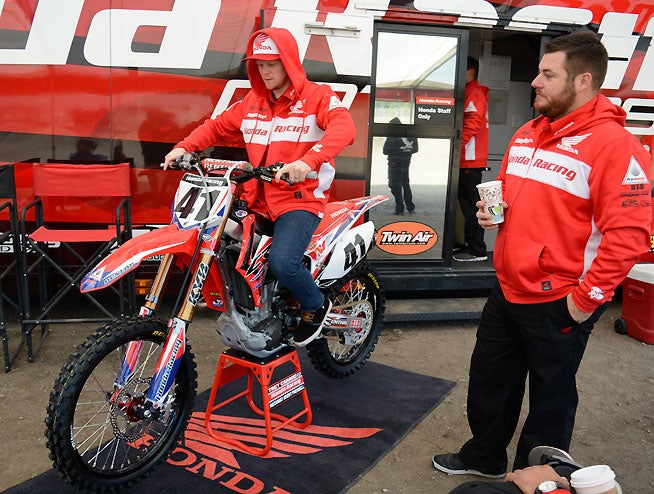
When it comes to professional supercross and motocross, the names of the top riders roll off the tongues of most fans fairly easily. Villopoto. Roczen. Canard. Dungey. All are instantly recognizable when it comes to the best of the best in the 450cc class. The same can be said for the 250cc ranks, where names such as Martin, Cianciarulo, Anderson and Seely are among those that instantly come to mind.
It’s a little bit different in the world of the motocross mechanic, however. Outside of perhaps Mike Gosselaar and Jeremy Albrecht, few but the most hard-core fans can recite the names of the hidden heroes who keep the machines under the sport’s best riders looking fresh and running to their top potential.
For Team Honda’s 450cc factory riders, those heroes go by the name of Brent Presnell and Rich Simmons. Presnell, 30, has been Trey Canard’s mechanic since Canard was just 13 years old, and he has shared in the triumphs and tragedies that the tenacious Canard has experienced over the past several seasons. Likewise, Simmons has been with newly signed Team Honda rider Cole Seely throughout his years as a rider with the Troy Lee Designs Honda team in the 250cc class. When Seely was moved onto the factory 450cc team for 2015, Simmons came with him.
At a recent Team Honda press function, Presnell and Simmons were on hand to discuss the team’s latest 450cc factory bikes, how they keep them in top shape and the similarities and differences of their respective riders. Both men are extremely optimistic that if Canard and Seely can stay healthy, Team Honda could have a real breakout year in 2015.
Of course, the factory Honda CRF450R is based on the stock 2015 machine, which is visually different than the 2014 in one obvious area.
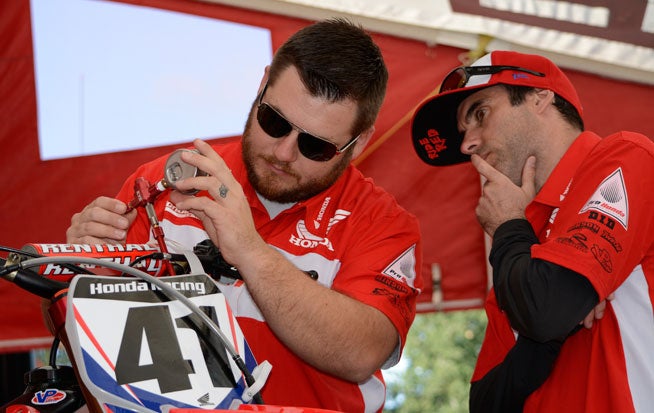
“The biggest difference people are going to notice is that our exhaust now exits to the right side of the bike instead of the left, and now we have more of a conventional headpipe,” Presnell says. “That was a production change that is way above my pay grade, but for us [the race team], it involved an all-new cylinder head and radiators, and the new cylinder head configuration offers a lot of power advantages. We are excited about that.
“It has allowed us to do all kinds of stuff, but I can’t tell you what,” Presnell adds with a smile.
What we do know is that AMA rules prohibit teams from altering the bore and stroke to deviate from that of the engine that the manufacturer submits for homologation and the material and castings of the cylinders, cylinder heads and crankcases must be the same as an originally approved model of the same manufacturer. Material may be added or removed from these items, and cylinder liners or coatings may be replaced or added provided the original cylinder casting is retained. On four-strokes, the cylinder head valve angles must remain the same as the homologated model, and the intake must be the same as the homologated model as well.
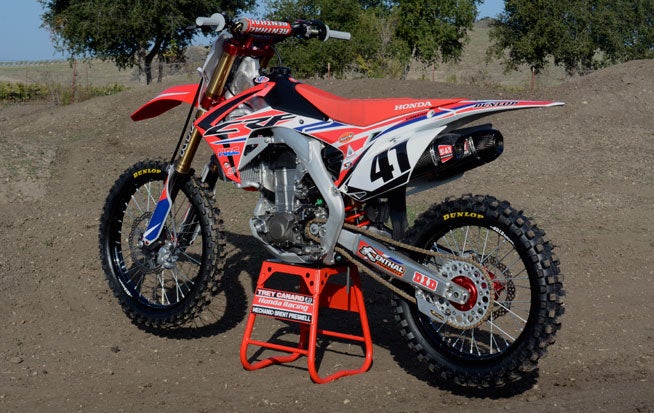
According to AMA Director of Supercross Kevin Crowther, violating the engine technical rules is not something that the sanctioning body is really concerned about where it pertains to the 450cc teams (the AMA is more concerned about unauthorized chassis modifications). Presnell says that the teams don’t need to stretch the engine rules to gain a performance advantage.
“We can make a 450 that is the fastest thing you’ve ever seen, but if our rider can’t hang onto it, it isn’t going to do any good,” Presnell said.
Shaping the abundant power that the 450s make is the key to success, and power character is one area where Canard and Seely differ. Honda has given the team leeway to develop engines that suit the needs of each individual rider.
“Trey is a very mid-range to top-end power kind of guy,” Presnell says. “He wants it to be pretty strong in the mid-range, and then he likes a lot of overrev. He wants to be able to leave it wide open and have it keep pulling. He doesn’t like to ride the rev limiter or anything like that. He also wants a very smooth and linear curve. He doesn’t want it to hit super hard and yank the bars out of his hands.”
Having just come up from the 250cc ranks, you would think that Seely would like a snappy, high-revving power flow in his bikes, but just the opposite is true, Simmons says. He prefers his engines to have a lot of low-end grunt and less of a top-end charge.
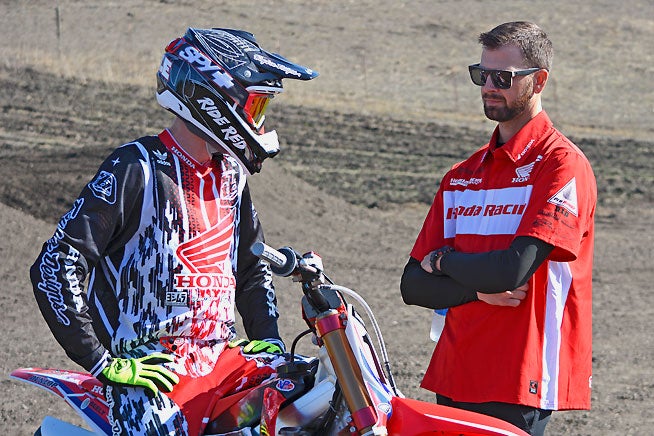
“A lot of guys ride really high in the rev range, but Cole rides really low,” Simmons says. “He has more of a BMX-kind of style where he rides really low on the bike, and he doesn’t grip it hard. Cole wants his power in a little different spot than Trey. He likes the power down low and very smooth. So we have tested different porting in the heads and different cams, and Cole has chosen what he likes. It is interesting that they both still prefer the exact same gearing, though.”
All the factory team engines are built in-house at Honda’s Torrance facility. Neither Presnell nor Simmons are primarily responsible for engine building, although they will help out as necessary.
“We are involved,’ we’re capable,” Presnell says. “We will jump in and help rebuild engines if we are needed, but with as much as much traveling as we do, that really limits the time we would have to do it anyway. It is much more of a controlled environment when you have two or three guys who are dedicated to just that.”
While one might think that the factory’s seemingly unlimited resources would dictate that brand new components are used in every engine rebuild, Presnell says that is not necessarily the case. All of the components—crank, rod, piston, and so forth—have a life cycle that is measured in hours and is strictly adhered to. Each part is cleaned and inspected, and if no defects are present and the piece is still within in its usable hours, it is reused. Rebuilt heads are vacuum-checked to ensure that the valves are seated properly, and each engine is meticulously rebuilt to the team’s specs and then broken-in on a mule dyno with a chassis already set in place.
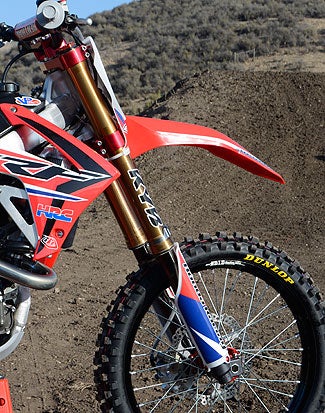
Presnell says that while the rules are pretty much “fair game” where it pertains to suspension modifications, the forks and shocks on Seely’s and Canard’s bikes are closer to stock than people might want to believe.
“People say, ‘works version,’ and there are a few components that are different internally, but a lot of that is just a coating so that it looks different,” Presnell said. “A lot of stuff I’m not allowed to reveal…sorry…but it is very close to the production version. The shock is the same way. The bodies and shafts might be a little different, but everything is really production-based.”
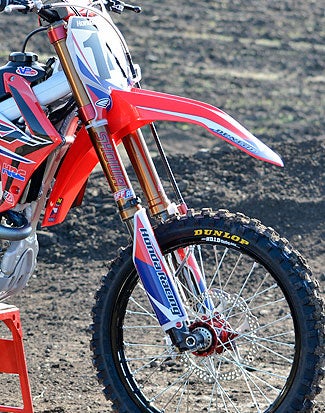
“For Cole’s riding style, the Showa is what he felt most comfortable with,” Simmons says, and Presnell adds, “Honda is really making changes to get back to the way it used to be, and that means that our riders were completely able to set up the bikes for themselves and try a lot of different components. Cole ended up sticking with the Showa fork, and Trey obviously went with the KYB.”
Naturally, a typical week for Presnell and Simmons is far from the 9 to 5 lifestyle that most of us experience. Much of their week away from the track is spent out practicing and testing with their riders. It’s a vicious cycle that runs from Thursday to Thursday rather than Monday to Friday like the average adult worker.
“Typically, we will travel on Thursday to the city where we are racing, get to the hotel and go to sleep, then Friday morning we go to the track and set up the truck” Presnell says. “We tackle any last-minute preparation stuff, and then take the bikes through tech inspection and the sound test. Saturday is race day, the full program, and then once that is done we tear everything down and get back to the hotel. Then Sunday we completely rebuild the motorcycle in the truck, usually in the parking lot of the hotel, and it is a full day of work. Parts-wise, everything is set up on a rotation for us, so we may have three engines—one in the bike, one in the truck and one back at the shop, getting rebuilt. The race engine from one weekend heads back to the shop, and the engine that is in the cupboard becomes the race engine. We grab it and put it in the chassis.”
The same goes for the suspension, which has a typical service life of two supercross races or one AMA National before being torn down and refurbished. Presnell says that one complete suspension set will be flown back to the shop for servicing while the other is on the bike. With the pieces packed in special carrying cases for shipping, it’s back to the airport to catch a flight home, then back to the practice tracks, the shop or wherever they are needed. It’s a vicious cycle. A grind. But it’s what they love to do.
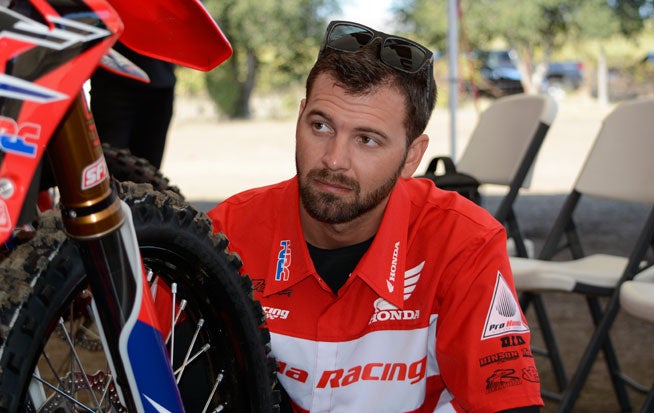
And just as their riders are expected to perform, so too are the mechanics, and they are driven by the same desire to win. Riders improve their chances by constant training, a rigid diet and a strict practice schedule. For the mechanics, knowledge is power.
“I tell everybody this: You can never stop learning,” Simmons says. “One of the things about coming over here to Honda is that there is such an opportunity to learn with the technology that they have. Working with the fuel-injection mapping and seeing how one small mapping change can have such a huge effect on the engine performance still blows me away.”
For Presnell, consistent solid results are the payoff for all the hard work, and he has a good feeling about how Canard and Seely will perform when the Monster Energy AMA Supercross Series gets underway with the season opener at Angel Stadium on January 3.
“I hope you will see them up front a lot next year,” Presnell says. “After the last few months, I kind of like my chances of being correct on that. You never know. Racing is one of those things that can bite you at any time, but I am really looking forward to it. We are in a really good spot.”
 Your Privacy Choices
Your Privacy Choices